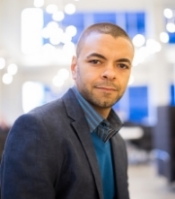by KARL SORENSEN
Engage Civil, a Chicago-based engineering startup, understands that just “fitting in” to the construction industry is no way to stand out, much less make a difference. “I remember how impressed I was when I showed up for an interview at my first large engineering company,” recounts Kelsey Taylor, Engage Civil’s president and founder. “Row upon row of shiny, new cubicles for as far as the eye could see. It was very organized… very regimented.”

But after a few years in that culture, Taylor began to see that physical environment as “either the cause of, or a symbol for, a ‘boxed-in’ kind of thinking,” he says. So, despite 20 years of solid industry experience at established firms like Sargent & Lundy, and Environmental Design International, a bookcase full of project accolades, and a seemingly set career path, he decided in 2013 to strike out on his own. His goal? “It’s first and foremost in the name,” he explains. “Engage…”
When engineers are truly engaged in a project within the context of the larger world, “a factually correct solution, derived by a very technically focused engineer, takes on a whole different dimension,” Taylor believes. With that in mind, he asks his engineers to reckon with a wider loyalty, and to ask themselves on every project, “What’s our ultimate purpose here?”
Such thinking isn’t the only thing different about the firm.
Engage Civil opened its doors in 2014 at a recently-launched, coworking space called Grind. The office building’s open floor plans, lounges and collaborative atmosphere keeps Taylor from “sinking too deeply into the cube mentality,” he says. And the atmosphere is conducive to attracting new, young talent to the space, and even to sparking surprising synergies between dissimilar firms, nevertheless filled with creative, energetic people.
Driving change on parallel paths
The American Society of Civil Engineers (ASCE) recently published a report called The Vision of Civil Engineering in 2025. At the time, unbeknownst to Taylor, his drivers of change ran parallel with the ASCE’s prediction of the civil engineering landscape for the next 10 years. Both saw a future shaped by environmental, technological, and globalization forces, all hopefully contributing to a better, brighter future for both the industry and the planet.
All about that space: The office at Grind LaSalle.
“Well I won’t lie, at first it wasn’t all applause and accolades,” smiles Taylor. “And, yes, some of those early naysayers definitely had their ‘I told you so’ moments. But thanks to those first clients who took that early risk with us, we’ve smoothed out those inevitable wrinkles, and managed to find our strengths.”
One of those strengths is Engage’s cloud-based use of technology. There are many companies that operate within the same field of work, but Taylor says he hasn’t run across any using a Mac operating system with CAD software quite the way Engage does. Thanks to its cloud-collaboration capabilities, the IT overhead is virtually eliminated, Taylor says. This is an advantage, he claims, because many competing firms choose to forego the more-streamlined platform in favor of already-installed, complex infrastructure that they had already invested in. “That’s fine by me,” he adds. “I get to pass those savings on to our clients. In fact, we’ve won every job that we’ve been invited to propose on.”
Taylor is more confident than ever that Engage Civil will see even more such invitations in 2015. Already, his team is working on a site design for a south suburban library that falls within the state’s new and aggressive Metropolitan Water Reclamation District (MWRD) ordinance to mitigate negative impacts of stormwater runoff. But more work and more new hires are just around the corner, a belief that reinforces his faith in the firm’s business model.
“Being engaged isn’t a hallmark of the typical engineer,” he observes. “But I hope our clients will continue to find it to be one of ours.”
Note: This article is from our archives. Some text, images, and links may not appear or function as originally formatted.


Discussion
Be the first to leave a comment.
You must be a member of the BuiltWorlds community to join the discussion.